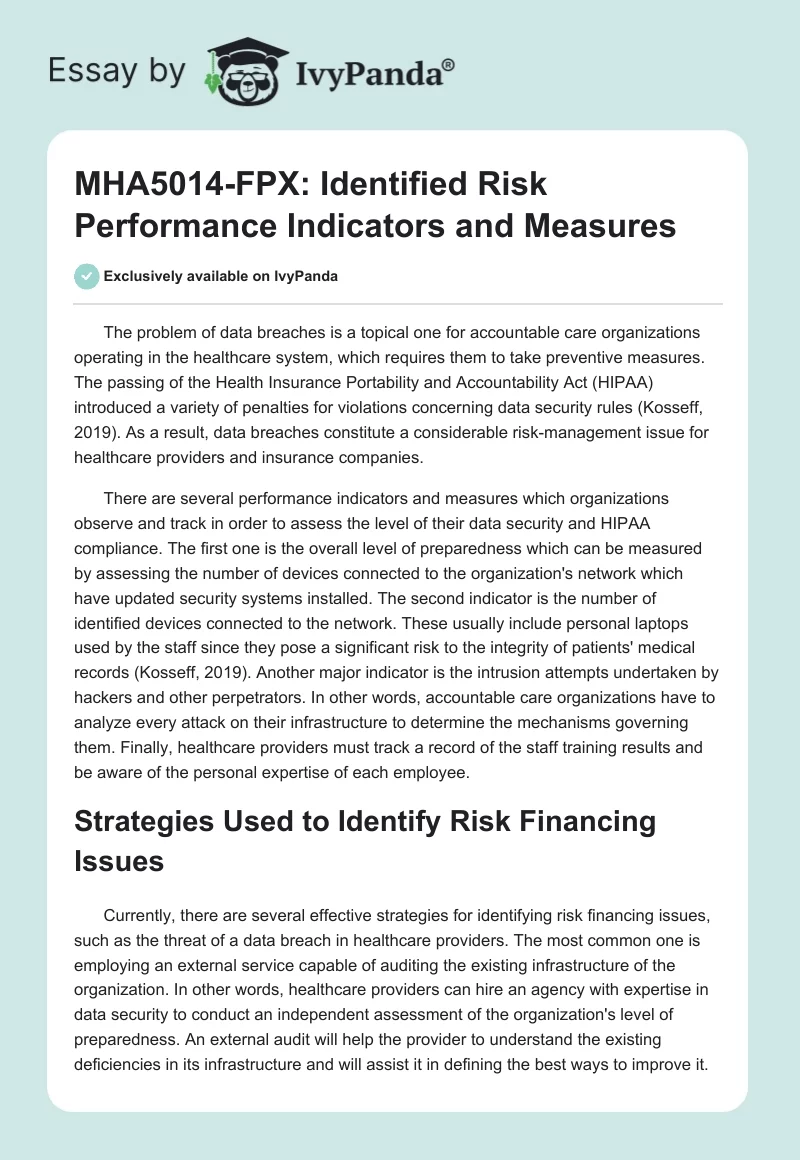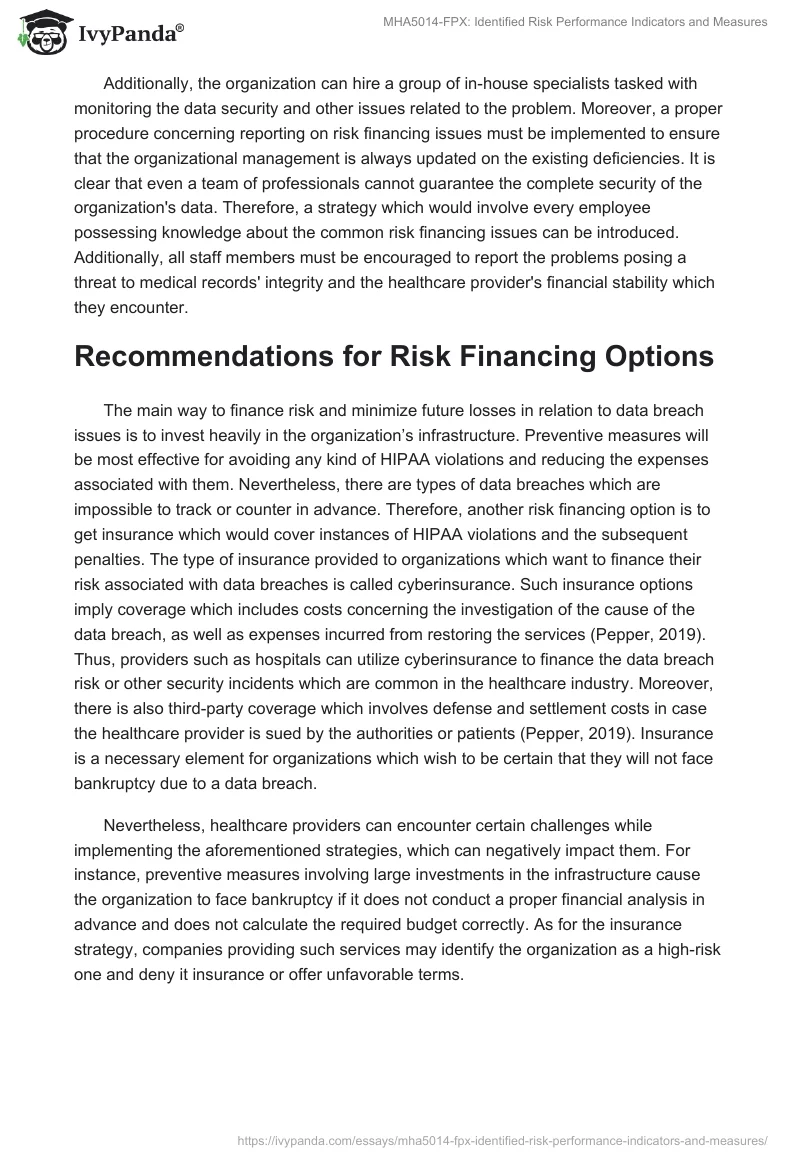The problem of data breaches is a topical one for accountable care organizations operating in the healthcare system, which requires them to take preventive measures. The passing of the Health Insurance Portability and Accountability Act (HIPAA) introduced a variety of penalties for violations concerning data security rules (Kosseff, 2019). As a result, data breaches constitute a considerable risk-management issue for healthcare providers and insurance companies.
There are several performance indicators and measures which organizations observe and track in order to assess the level of their data security and HIPAA compliance. The first one is the overall level of preparedness which can be measured by assessing the number of devices connected to the organization’s network which have updated security systems installed. The second indicator is the number of identified devices connected to the network. These usually include personal laptops used by the staff since they pose a significant risk to the integrity of patients’ medical records (Kosseff, 2019). Another major indicator is the intrusion attempts undertaken by hackers and other perpetrators. In other words, accountable care organizations have to analyze every attack on their infrastructure to determine the mechanisms governing them. Finally, healthcare providers must track a record of the staff training results and be aware of the personal expertise of each employee.
Strategies Used to Identify Risk Financing Issues
Currently, there are several effective strategies for identifying risk financing issues, such as the threat of a data breach in healthcare providers. The most common one is employing an external service capable of auditing the existing infrastructure of the organization. In other words, healthcare providers can hire an agency with expertise in data security to conduct an independent assessment of the organization’s level of preparedness. An external audit will help the provider to understand the existing deficiencies in its infrastructure and will assist it in defining the best ways to improve it.
Additionally, the organization can hire a group of in-house specialists tasked with monitoring the data security and other issues related to the problem. Moreover, a proper procedure concerning reporting on risk financing issues must be implemented to ensure that the organizational management is always updated on the existing deficiencies. It is clear that even a team of professionals cannot guarantee the complete security of the organization’s data. Therefore, a strategy which would involve every employee possessing knowledge about the common risk financing issues can be introduced. Additionally, all staff members must be encouraged to report the problems posing a threat to medical records’ integrity and the healthcare provider’s financial stability which they encounter.
Recommendations for Risk Financing Options
The main way to finance risk and minimize future losses in relation to data breach issues is to invest heavily in the organization’s infrastructure. Preventive measures will be most effective for avoiding any kind of HIPAA violations and reducing the expenses associated with them. Nevertheless, there are types of data breaches which are impossible to track or counter in advance. Therefore, another risk financing option is to get insurance which would cover instances of HIPAA violations and the subsequent penalties. The type of insurance provided to organizations which want to finance their risk associated with data breaches is called cyberinsurance. Such insurance options imply coverage which includes costs concerning the investigation of the cause of the data breach, as well as expenses incurred from restoring the services (Pepper, 2019). Thus, providers such as hospitals can utilize cyberinsurance to finance the data breach risk or other security incidents which are common in the healthcare industry. Moreover, there is also third-party coverage which involves defense and settlement costs in case the healthcare provider is sued by the authorities or patients (Pepper, 2019). Insurance is a necessary element for organizations which wish to be certain that they will not face bankruptcy due to a data breach.
Nevertheless, healthcare providers can encounter certain challenges while implementing the aforementioned strategies, which can negatively impact them. For instance, preventive measures involving large investments in the infrastructure cause the organization to face bankruptcy if it does not conduct a proper financial analysis in advance and does not calculate the required budget correctly. As for the insurance strategy, companies providing such services may identify the organization as a high-risk one and deny it insurance or offer unfavorable terms.
Legal and Ethical Financial Risk Obligations
Data breaches and other types of security issues, according to HIPAA, entail considerable legal obligations. Currently, there are four categories of HIPAA violations with different financial penalties. For instance, the first category involves violations which a healthcare provider was not aware of and could not prevent even if they tried to abide by the rules (Zelman et al., 2020). Such violations can cost providers from hundred dollars up to fifty thousand dollars. Similarly, organizations can be charged the same amounts for violations which they should have been aware of but could not avoid. The harshest penalties are associated with the fourth category, which involves violations related to willful neglect, and they may lead to criminal charges and up to ten years in prison. Therefore, providers have to be extremely careful when countering various types of HIPAA violations.
At the same time, there ethical financial risk obligations related to each incident of a data breach. Namely, any type of data security issue may lead to the leak of the medical records of patients. As a result, healthcare providers have an ethical obligation to prevent such events since they negatively affect their reputation. Moreover, accountable care organizations have to notify their clients in case when their medical records or any other type of personal data gets compromised.
References
Kosseff, J. (2019). Cybersecurity law. John Wiley & Sons.
Pepper, J. (2019). The electronic health record for the physician’s office. Elsevier Health Sciences.
Zelman, W., McCue, M., Glick, N., & Thomas, M. (2020). Financial management of health care organizations. John Wiley & Sons.


